首先是关于希腊字符的发音,每个字符对应有一个单词,通过单词则可在词典中听它们的发音,下图给出每个字符的发音,当然英语读音和原始的希腊读音肯定是有区别的,不过还是以英语发音为主吧。

关于希腊字符的写法就比较麻烦,有自己的风格就好,不用太强求,下面是是正确的笔顺,来自 http://www.foundalis.com/lan/hw/grkhandw.htm
| Uppercase (Capital) | Comment | Lowercase | Comment |
 |
Same as Roman A. | 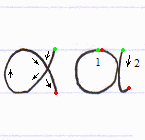 |
The first of the two is the most typical, “the Greek way” of writing an alpha. Some Greeks, however, write it just like a common hand-written version of the Roman a, as shown on the right. If you prefer your writing to look more genuinely Greek, use the first way; but if you like the safety of the familiar, you may use the second way. |
 |
Same as Roman B. | 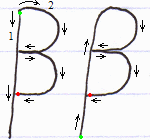 |
Two ways to draw a beta, differing only in the starting point of the strokes. The first way yields a more squarish beta at the top, and is done in two strokes. The second way yields a more roundish top, and is done in a single stroke (but starts a bit awkwardly at the bottom). Use whatever seems more convenient to you. |
 |
Note: many non-native writers tend to put a little vertical “tail” at the end of the second stroke, seeing it in printed forms of this letter ( Γ ). That’s a serif! It does not belong to the basic form of gamma any more than the serifs at the end of the horizontal bar of a capital T belong to it. When we write, we usually do not mark the serifs. |
 |
Not really different, the two ways depend on where you make the crossing point. Making it higher than the notebook line (first way) is more convenient in handwriting. Making it right at the line (second way) is more like the printed letter. |
 |
An alternative order to draw the strokes is just as in A, with the horizontal line (3rd stroke) being the base of the triangle. |
 |
When written quickly, the angle at the top-left usually comes out as a curve. |
 |
Same as Roman E. |  |
An alternative way to draw this letter is like a c with a horizontal line in the middle (like this: є, or just as the math symbol for “belongs” — for whomever is familiar with that — but in small size). |
 |
Same as Roman Z. |  |
The length of the top horizontal line doesn’t matter. Also, that line is sometimes slightly curved like a wide-open bowl. The hook at the bottom can be more closed or more open. |
 |
Same as Roman H (but note that this is the Greek vowel eta). |
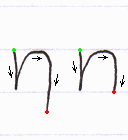 |
The first form is less common, but more consistent with Greek-style hand-writing. The second form is more common, and appears more familiar to non-Greeks, since it’s identical to the Roman letter n. |
 |
Like an O with a horizontal bar bisecting it. | 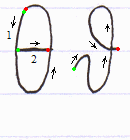 |
The first form is thinner than its corresponding capital letter. The second form is cursive. |
 |
Same as Roman I. |  |
Same as Roman i without the dot. |
 |
Same as Roman K. | 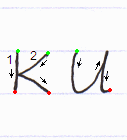 |
The second form (which looks like the Roman u) is cursive but quite common — perhaps more common than the first form. |
 |
Same as an A without the horizontal bar. |  |
Sometimes stroke #1 ends with a little hook pointing to the right. |
 |
Same as Roman M. |  |
Drawing the strokes in the given order makes it a bit more cursive (preparing for the next letter). But you can also draw a Roman u first, and then extend the line on the left. |
 |
Same as Roman N. | 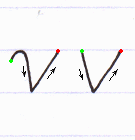 |
If you want to distinguish the Greek ν from the Roman v, use the first form. |
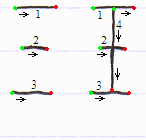 |
A very rare letter. The second form probably exists so that the letter doesn’t appear discontinuous. |
 |
Looks complicated, but it’s actually like a lowercase zeta (see it above), the curve of which has acquired an extra spike. Another way to see it is as a final sigma (or Roman s) on top of which stands a lowercase cursive tau (see it below). |
 |
Same as Roman O. |  |
Same as Roman o. |
 |
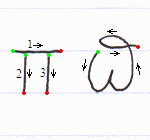 |
The second form is cursive, and quite rare. | |
 |
Same as Roman P (but note that this is the Greek rho). |  |
Don’t confuse the Greek ρwith the Roman p. The former has a complete circle, whereas the latter is nearly semicircular. |
 |
The mid-point can sometimes be drawn so that it reaches as far to the right as the upper and lower end-points, but more commonly it stands a little to the left of those. | 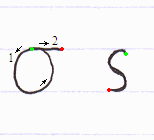 |
In the first form, the top horizontal line is about as long as 1/2 diameter (or 1 radius) of the circle. The second form is the final sigma only (never use it instead of the mid-word sigma), and is identical to the Roman s. Note: some books written by non-Greek authors might suggest the Byzantine form c instead. Nobody writes a sigma like that today, save for the Greek Orthodox Church. |
 |
Same as Roman T. | 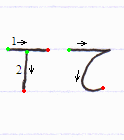 |
The second form is cursive, and perhaps more common than the first one. |
 |
Same as Roman Y (but note that this is the Greek upsilon). |  |
The hook on the left is optional, but usually present. |
 |
The circle can sometimes be larger, reaching further down, and sometimes (rarely) all the way to the bottom line. | 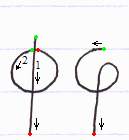 |
The second form is calligraphic, and quite common. |
 |
Same as Roman X (but note that this is the Greek chi). | 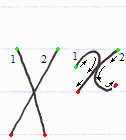 |
The second form is cursive, and not very common. |
 |
As with Φ (above), the curve can sometimes be larger, reaching further down, but never all the way to the bottom line. | 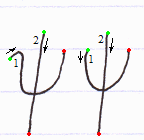 |
The second stroke often starts at the same height as the two end-points of the bowl. |
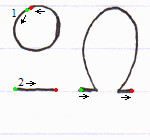 |
Both forms are equally common. |  |
|